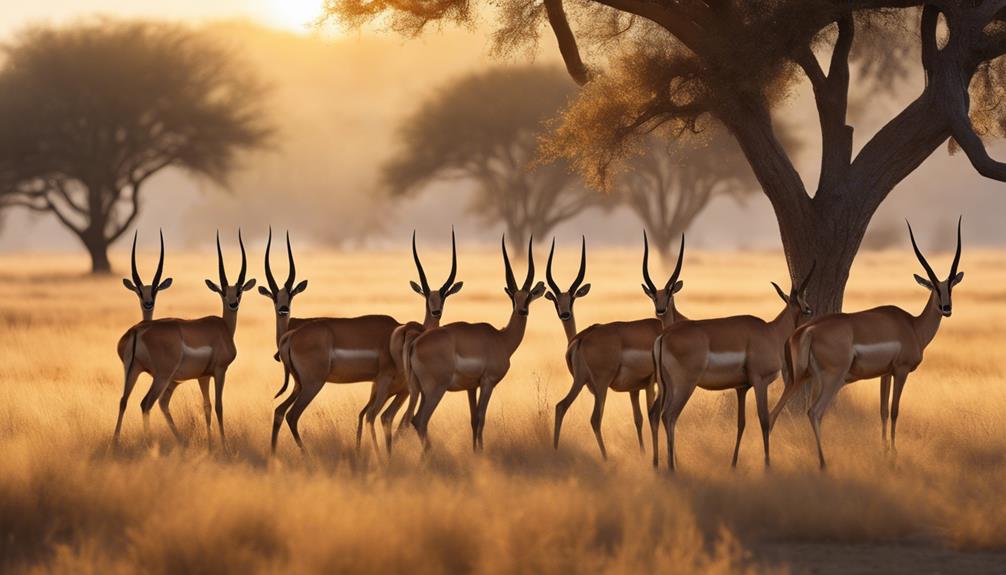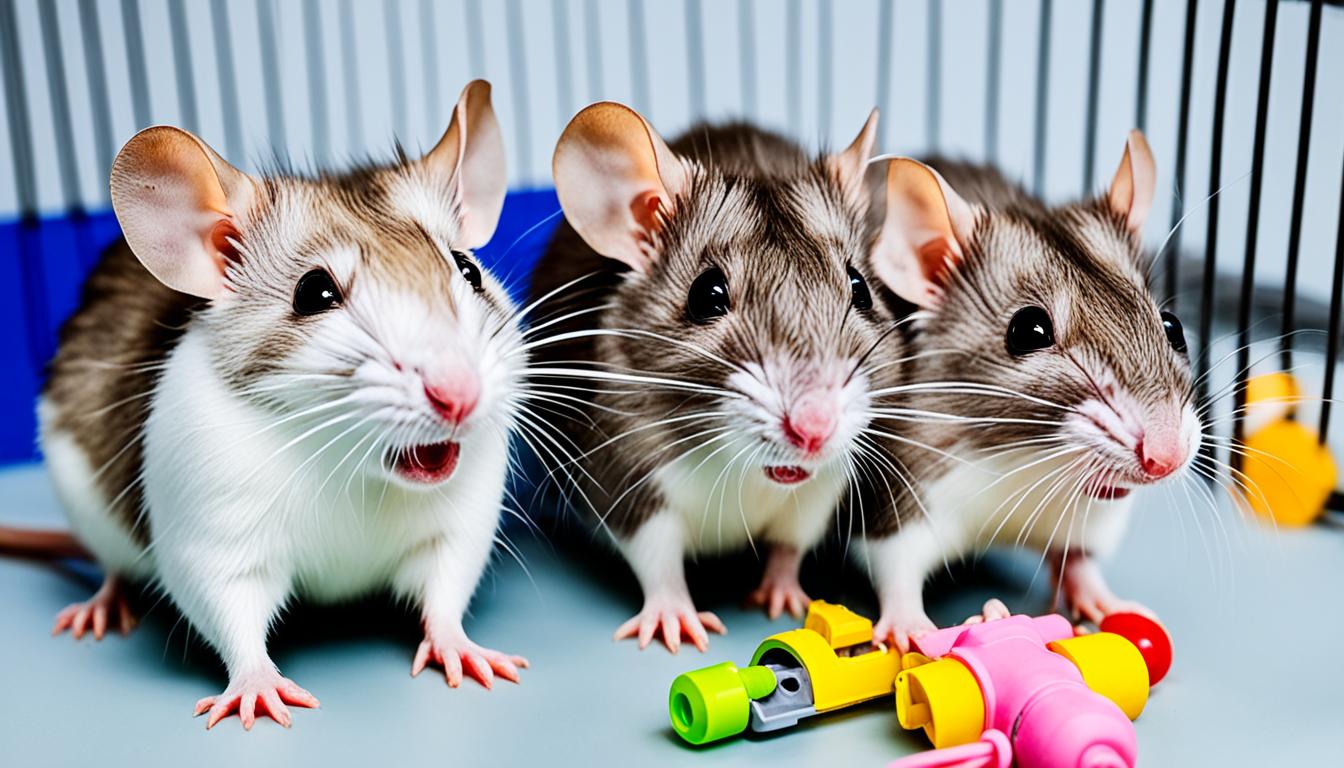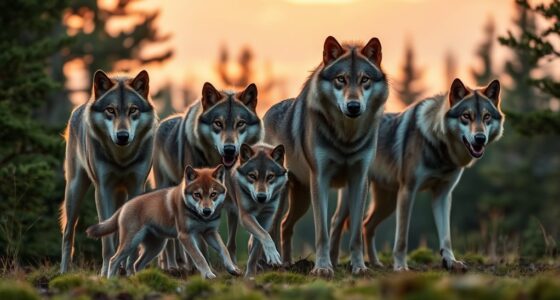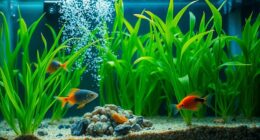If you're curious about animals like deer, consider elk, moose, caribou, and sambar deer. Elk are impressive with huge antlers for sparring. Moose are giant herbivores with massive antlers. Caribou are Arctic deer that migrate thousands of miles. Sambar deer, found in Asia, are the largest deer species. These creatures share traits with graceful deer, living in various habitats around the world. Want to find out more about these fascinating animals?
Key Takeaways
- Moose: Large herbivore with impressive antlers, similar to deer in size and habitat preferences.
- Caribou: Arctic deer with unique antler growth, engaging in long migrations like certain deer species.
- Fallow Deer: Resemble deer with palmate antlers, native to Europe and adaptable to various habitats.
- Sika Deer: Agile cervid species, similar to deer in behavior and adaptable to diverse environments.
- Sambar Deer: Largest Asian deer species, comparable to deer in size and habitat preferences.
Elk: Majestic Cervidae Species
Elk, a majestic Cervidae species closely related to deer, are known for their impressive size and distinctive antlers. These antlers aren't only for display but serve important purposes. They're used during the mating season for competitive sparring among male elk to establish dominance and access to mates. The antlers can reach substantial sizes with multiple points, making each set unique to the individual elk. Observing these antlers can provide insights into an elk's age and health, making them valuable tools for researchers and wildlife enthusiasts.
Understanding the growth and development of elk antlers is essential for appreciating the complexity of these magnificent creatures. Antlers are one of the fastest-growing tissues in the animal kingdom, capable of growing up to an inch per day. They're composed of bone-like tissue and are shed and regrown annually. This continuous cycle of growth showcases the remarkable adaptability and resilience of elk in their natural habitats.
Moose: Large Herbivore With Antlers

Moose, the giants of the deer family, boast impressive antlers that can span up to 6 feet and weigh around 40 pounds.
These majestic herbivores primarily inhabit regions in North America, with populations thriving in Canada, Alaska, and parts of the northern United States.
Their sheer size and remarkable antlers make them a sight to behold in their natural habitats.
Moose Antler Size
During mating season, the impressive size of moose antlers, spanning up to 6 feet across, serves as a display of dominance among male moose. These antlers, weighing up to 40 pounds each, are the largest among deer species. Their palmate shape, with broad, flat extensions, distinguishes them from other antler types.
Remarkably, a mature bull moose can grow its antlers at a daily rate of up to an inch during peak periods. The size and weight of these antlers play an important role in establishing dominance and attracting mates.
Observing moose antlers in the wild showcases the incredible natural adaptations of these magnificent animals, highlighting their strength and evolutionary prowess.
Moose Habitat Range
Roaming through the vast wilderness of North America, the moose establishes its habitat range amidst abundant vegetation and near water sources, embodying the essence of a large herbivore with formidable antlers. Moose are primarily found in North America, spanning from Alaska and Canada down to the northern United States. They thrive in areas with rich vegetation close to water bodies such as lakes, rivers, and marshes. These adaptable creatures are well-suited to cold climates, excelling in boreal and mixed forests, mountains, and taiga ecosystems with dense browsing opportunities. Solitary by nature, moose choose their habitats based on food availability and the presence of protective cover.
| Habitat Range | Vegetation | Water Sources |
|---|---|---|
| North America | Abundant | Lakes, rivers |
Caribou: Arctic Deer With Migration

A notable aspect of caribou, the Arctic deer species renowned for their extensive migrations, is their specialized hooves designed for traversing snow and ice. These hooves act like snowshoes, spreading out to support the caribou's weight and preventing them from sinking into the soft snow. This unique adaptation allows caribou herds to travel long distances in search of food and to avoid predators in the harsh Arctic environment. Their annual migrations can span thousands of miles, following traditional routes ingrained in their species' memory.
Both male and female caribou grow antlers, with males typically having larger and more branched antlers compared to females. These antlers are shed and regrown annually. However, caribou populations are facing challenges such as climate change, habitat loss, and increased predation, which are impacting their iconic migratory behavior and overall survival. It's essential to protect these Arctic deer to safeguard the continuation of their unique migratory patterns and the biodiversity of the Arctic ecosystem.
Reindeer: Festive Cervidae of North

Reindeer, intriguing creatures found in the North, boast a habitat tailored for the harsh Arctic environment. Their behavior offers insights into their social dynamics and unique adaptations for survival in extreme conditions.
Highlighting their specialized hooves, impressive migrations, and both genders growing antlers, reindeer are a captivating study in adaptability and resilience.
Reindeer Habitat Overview
In the vast and icy landscapes of the Arctic and subarctic regions, reindeer, known as caribou in North America, establish their habitat, embodying a unique harmony with their environment. These magnificent creatures have adapted to thrive in harsh conditions, with their specialized hooves acting like snowshoes, enabling them to walk on snow and ice effortlessly.
The reindeer's migration patterns are awe-inspiring, covering thousands of miles annually, making them one of the longest migrating land animals on the planet. Not only are reindeer remarkable in their physical adaptations, but they also hold significant cultural and ecological importance to indigenous peoples in the Arctic, showcasing the intricate interconnectedness between these majestic animals and the communities that rely on them.
Reindeer Behavior Insights
Establishing a deeper understanding of reindeer behavior reveals fascinating insights into the festive Cervidae of the North. Reindeer showcase unique behaviors that set them apart from other hoofed animals. Let's explore some intriguing aspects of their behavior in the table below:
| Behavior | Description |
|---|---|
| Snow Digging | Reindeer use their hooves to dig craters in the snow, allowing them to access hidden food sources. |
| Lichen Uncovering | These animals employ their hooves to uncover lichen, an essential food source during harsh winter months. |
| Migration Patterns | Reindeer are known for their long migrations, spanning over 3,000 miles annually, showcasing their adaptability. |
Reindeer Adaptations Highlighted
With their unique adaptations highlighted, the festive Cervidae of the North, known as reindeer, exhibit remarkable survival strategies in their arctic environment.
Reindeer, also called caribou in North America, are the only deer species where both males and females grow antlers. Their specialized hooves act like snowshoes, allowing them to navigate snow and ice effortlessly.
These cervids undergo extensive migrations, traveling up to 3,000 miles annually, ranking among the farthest migrating mammals. Their thick coat changes color with the seasons, providing effective camouflage in the arctic habitat.
Additionally, reindeer have a distinctive nasal structure that warms the cold air they breathe, aiding their survival in harsh climates. These adaptations showcase the incredible resilience of reindeer in their challenging environment.
Fallow Deer: Elegant European Ungulate

Marveling at the graceful movements of the fallow deer, one can't help but be captivated by their elegant presence in the European landscape. These elegant creatures, native to Europe and Asia, have been introduced to various regions worldwide for hunting and ornamental purposes.
Standing out with a variety of coat colors such as spotted, white, and melanistic (black), fallow deer showcase their adaptability to different environments. Here are some fascinating facts about these European ungulates:
- Fallow deer exhibit a range of coat colors, including spotted, white, and melanistic (black), adding to their visual allure.
- The males of this species possess palmate antlers, shed annually, which are used for display and competition, enhancing their majestic appearance.
- Social animals by nature, fallow deer form herds led by dominant males during mating season, showcasing their complex social structures within the herd dynamic.
Red Deer: Iconic European Cervid Species

Red deer, as one of the largest native deer species in Europe and parts of Asia, showcase impressive antlers that can span up to 1 meter in width. These majestic creatures, also known as stags when referring to males, play a significant role in European folklore and are often linked to the mythical 'wild hunt.'
Their distinctive reddish-brown fur color, particularly striking in the summer, adds to their allure. Red deer are highly adaptable beings, thriving in diverse habitats ranging from woodlands to moorlands and even mountainous regions. Their ability to navigate such varied landscapes showcases their resilience and evolutionary prowess.
Observing these iconic cervids in the wild can be a mesmerizing experience, offering a glimpse into the natural world's beauty and complexity. Whether roaming through dense forests or traversing rugged terrains, red deer epitomize the grace and strength of wild animals, making them a symbol of Europe's rich biodiversity.
Sika Deer: Asian Small Deer Variant
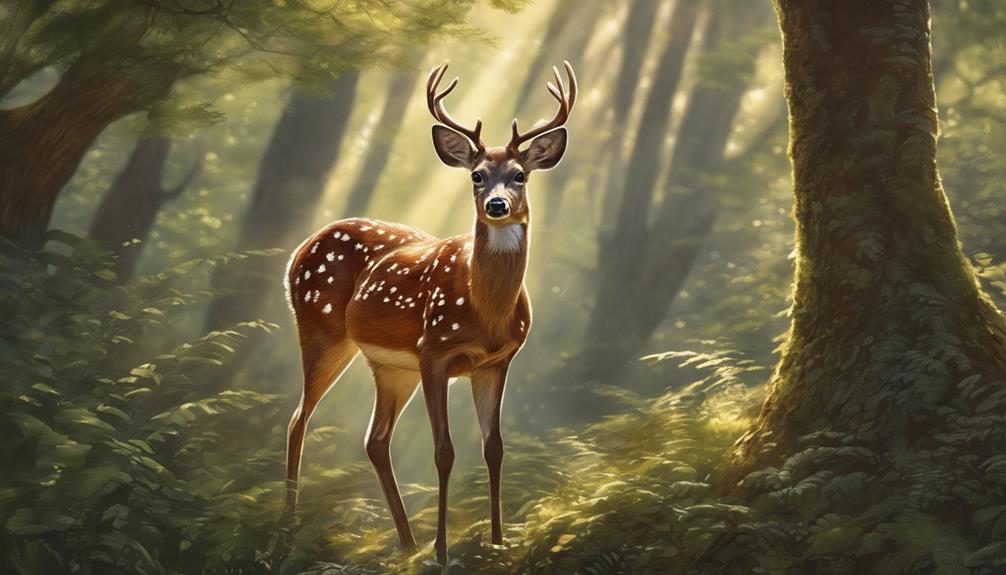
Sika deer, originating from East Asia, boast a reddish-brown coat adorned with distinctive white spots. These petite deer, typically weighing around 90-100 pounds, are recognized for their smaller, less branched antlers compared to other species.
As we explore the Sika deer's features, habitat, behavior, and conservation efforts, we'll uncover the intriguing world of this Asian small deer variant.
Sika Deer Features
Sika deer, originating from East Asia, are known for their adaptable nature and distinct features. These small deer exhibit characteristics that set them apart from other species:
- Size: Sika deer are smaller than most deer, with males typically weighing between 90 to 150 pounds.
- Vocalizations: Known for their unique calls, sika deer produce high-pitched sounds, especially during the rutting season.
- Coat Color: Their coat can range from reddish-brown to almost black, often adorned with white spots in the summer.
These features make sika deer not only fascinating to observe but also essential members of their ecosystems, thriving in diverse habitats from forests to marshlands.
Habitat and Behavior
Inhabiting diverse landscapes ranging from forests to marshes, these agile small deer demonstrate a remarkable adaptation to their surroundings. Sika deer, native to East Asia, are known for their solitary nature and territorial behavior. They showcase remarkable swimming abilities, often being spotted near water bodies.
The males sport distinctive antlers that are shed and regrown annually, adding to their allure. Their diet includes a variety of foods such as grass, leaves, berries, and even agricultural crops. These unique behaviors and habitat preferences contribute to the mystique surrounding these fascinating creatures.
The ability to thrive in various environments showcases their resilience and adaptability, making them a truly captivating species to observe.
Conservation Efforts
Monitoring Sika Deer populations closely is crucial for developing effective conservation strategies aimed at preserving their genetic diversity and habitat. To guarantee the survival of these small Asian deer, conservation efforts include:
- Implementing habitat restoration projects to create suitable environments for Sika Deer to thrive and expand their populations.
- Conducting research on the ecological role of Sika Deer to assess their impact on local ecosystems and biodiversity conservation.
- Facilitating collaborative efforts between conservation organizations and local communities to raise awareness and garner support for Sika Deer conservation initiatives.
Through these initiatives, we can work towards safeguarding the future of Sika Deer and their natural habitats.
Sambar Deer: Large Deer of Asia
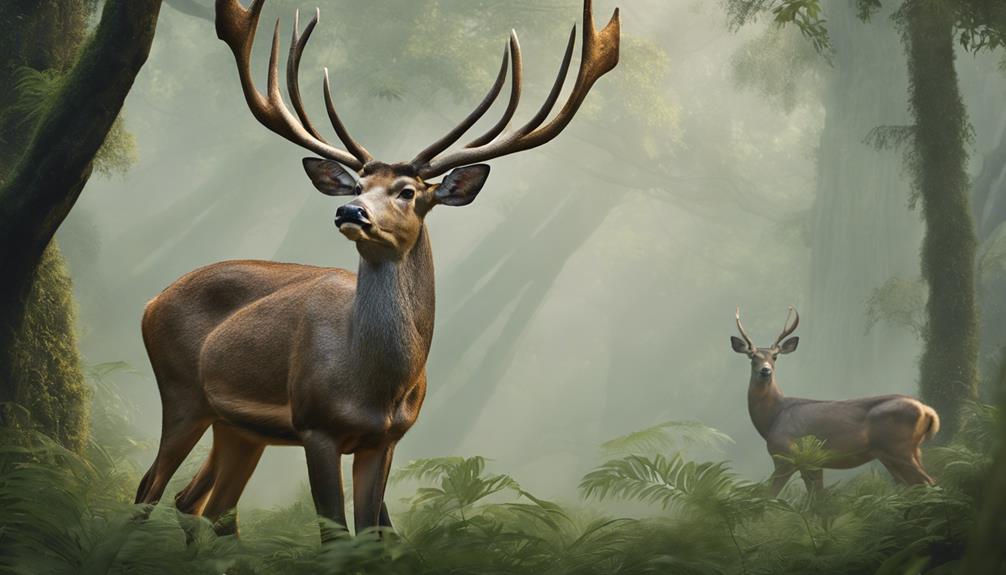
Sambar deer, the largest deer species in Asia, are known for their impressive size, striking appearance, and nocturnal behavior. These majestic creatures can weigh up to 1,200 pounds, sporting a dark brown coat, long manes, and impressive antlers that make them a mesmerizing sight in their natural habitat. Found primarily in dense forests and grasslands across Southeast Asia and the Indian subcontinent, Sambar deer are solitary animals that prefer to roam and forage for food under the cover of night.
Their role in forest ecosystems is crucial, as they contribute to seed dispersal and influence plant growth through their browsing habits. By understanding the behavior and habits of Sambar deer, we gain insight into the delicate balance of nature and the interconnectedness of species within an ecosystem. Observing these magnificent creatures in their natural environment provides a unique opportunity to appreciate the beauty and diversity of wildlife in Asia.
Roe Deer: Dainty Eurasian Cervid
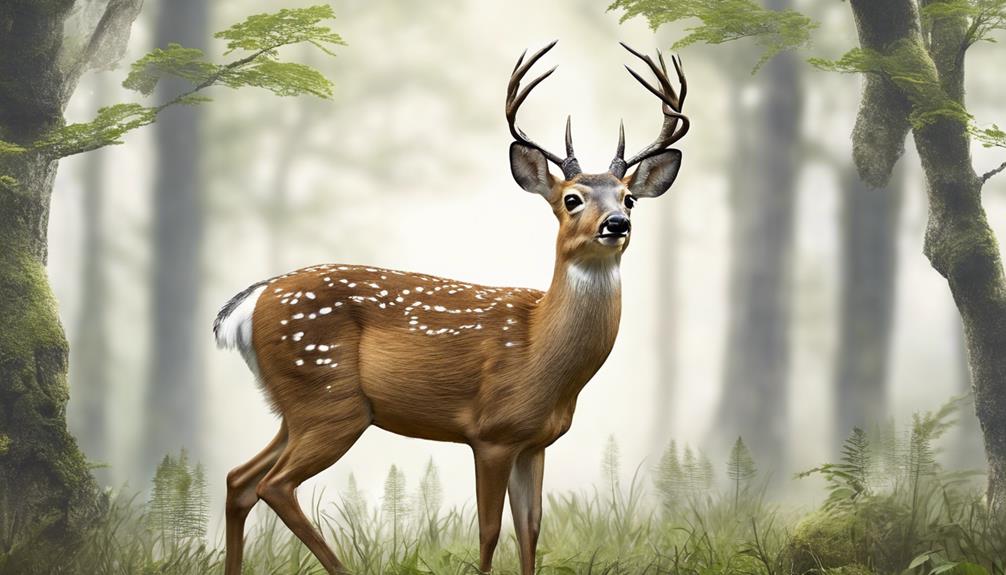
Roe deer, known for their dainty stature and distinctive reddish-brown fur, are a species of small to medium-sized deer found in Europe and Asia. These elegant creatures have captured the attention of many with their unique characteristics.
- Roe deer are primarily browsers, enjoying a diet of leaves, shoots, berries, and even tree bark. Their feeding habits contribute to the ecosystem by helping with seed dispersal and maintaining plant diversity.
- Males of the species grow simple, single-pointed antlers that they shed and regrow annually. These antlers play a role in mating rituals and establishing dominance within the herd.
- Roe deer are incredibly adaptable, thriving in various habitats ranging from woodlands and farmlands to even urban areas. Their ability to adjust to different environments showcases their resilience and versatility in the wild.
Observing roe deer in their natural habitats offers a glimpse into the beauty and complexity of these fascinating Eurasian cervids.
Axis Deer: Spotted Deer From India

Thriving in the woodlands of India, the Axis deer, also known as spotted deer, stand out with their striking red coats adorned with white spots and long antlers. These elegant creatures boast a unique appearance with a distinctive black stripe running along their backbone, adding to their charm. In Texas, the Axis deer population ranges from 30,000 to 40,000, making them a significant species in the state. Their beauty and grace make them highly sought after by wildlife enthusiasts and hunters alike.
| Unique Features of Axis Deer | |
|---|---|
| Origin: | India |
| Coat Color: | Red with white spots |
| Antlers: | Long and impressive |
| Special Marking: | Black stripe on back |
The Axis deer's striking appearance and adaptability have made them a popular species for both observation and conservation efforts. Their presence in different ecosystems highlights their versatility and resilience as a species. Whether in their native India or the vast landscapes of Texas, the Axis deer continue to captivate and inspire all who encounter them.
Frequently Asked Questions
What Animal Is Similar to a Deer?
An animal similar to a deer is the caribou, also known as a reindeer. Caribou share many characteristics with deer, such as their appearance and belonging to the same family, Cervidae.
What Are Deer Closest Related To?
Deer are most closely related to other even-toed hoofed animals like moose, elk, and caribou. Taxonomically, they share relation with giraffes and bovids. Evolving from a common ancestor with ruminants like cattle and buffalo, deer exhibit genetic closeness to antelope and gazelle species.
What Animal Is Like a Deer but Smaller?
When considering animals like deer but smaller, the Pudu deer stands out. It's one of the tiniest deer species globally, with cute features and excellent jumping abilities. Pudu deer showcase nature's amazing diversity in the animal kingdom.
What Is Like a Deer but Bigger?
Moose, elk, caribou, sambar, and red deer are akin to deer but grander. Their sizes and qualities make them majestic creatures. Moose mesmerize with their immense weight, while elk impress with their antlers. Caribou and sambar are remarkable in their own right.
Are Deer Considered Hardworking Animals in the Wild?
Deer are not typically known as animals working hard in the wild. They spend their time foraging for food, seeking shelter, and protecting themselves from predators. While they are well-adapted to survival in the wild, they are not considered hardworking in the same way as some other animals.
Conclusion
As you explore the intriguing world of wild animals similar to deer, remember to tread carefully and observe from a safe distance. These majestic creatures possess unique characteristics that make them truly enthralling.
Stay tuned for more exciting encounters with these wild animals, as their natural habitats hold endless mysteries waiting to be discovered.
Stay curious and always respect the beauty and wonder of nature. Who knows what other amazing creatures you may encounter in the future!
